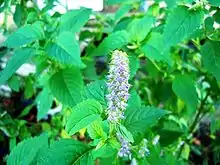Elsholtzia ciliata
Elsholtzia ciliata, commonly known as Vietnamese balm, xiang ru (香薷) or kinh giới in Vietnamese, is a plant native to Asia. In the US it can go by the name Crested Late Summer Mint. In US Vietnamese grocery stores is called Kinh Gioi, Vietnamese Lemon Balm or Vietnamese Lemon Mint.[1]
| Elsholtzia ciliata | |
|---|---|
 | |
| Scientific classification | |
| Kingdom: | Plantae |
| Clade: | Tracheophytes |
| Clade: | Angiosperms |
| Clade: | Eudicots |
| Clade: | Asterids |
| Order: | Lamiales |
| Family: | Lamiaceae |
| Genus: | Elsholtzia |
| Species: | E. ciliata |
| Binomial name | |
| Elsholtzia ciliata (Thunb.) Hyl. | |
| Synonyms | |
|
Elsholtzia cristata, Willd. | |
Distribution
The plant is native to Asia. However, the exact extent of its original range is unclear.[2]
Today it is found through much of India, eastern Asia, and Europe. It grows throughout Nepal at elevations of 1500 to 3400 m.
Description
Elsholtzia ciliata is an erect herb that grows to about 60 cm in height. The leaves are long, stalked, and serrated, and reach 2 to 8.5 cm in length and .8 to 2.5 cm in width. In shape they are ovate to lanceolate, with a gland-dotted underside.
Flowers of a purple color bloom in flat spikes in September and October. Seeds propagate within them.
Uses
Elsholtzia ciliata has many cultural uses.
Culinary
It is used in Vietnamese cuisine, where it is called rau kinh giới or lá kinh giới. The leaves are used to flavor meat dishes, soups and salads with a lemony flavor.[3]
The seeds are sometimes powdered and used for flavoring food.
Traditional medicine
It is used common in herbal medicine, as it is considered to be carminative and astringent.[4] In Traditional Chinese Medicine, it is known as xiang ru (香薷) or aromatic madder and is used for stomach problems, to induce sweating, and also for halitosis.
Cultivation
It is cultivated as an ornamental plant. It prefers moist soil, and grows mostly on exposed rocky slopes and other open, gravelly areas.[5] Propagated by both seeds and rhizomes. It is banned in the state of Connecticut and classified as an noxious weed in 46 states. It was first reported in the Americas as a weed in 1889.
Gallery
 Growing in Shangri-La, Yunnan province, China
Growing in Shangri-La, Yunnan province, China Growing in Shangri-La, Yunnan province, China
Growing in Shangri-La, Yunnan province, China Growing in Shangri-La, Yunnan province, China
Growing in Shangri-La, Yunnan province, China
References
- "Kinh Gioi". www.kitazawaseed.com. Retrieved 2020-09-30.
- Wiersema, John H; Leon, Blanca (February 26, 1999). World Economic Plants. CRC Press. p. 200. ISBN 0-8493-2119-0.
- "Vietnamese Balm, Kinh Gioi (Elsholtzia ciliata) | My Garden Life". www.mygardenlife.com. Retrieved 2020-09-30.
- Manandhar, Narayan P; Manandhar, Sanjay (April 1, 2002). Plants and People of Nepal. Timber Press. p. 217. ISBN 0-88192-527-6.
- Monachino, Joseph (1958). Elsholtzia ciliata in New York. Bulletin of the Torrey Botanical Club. Torrey Botanical Society.
Bibliography
- Pink, A. (2004). Gardening for the Million. Project Gutenberg Literary Archive Foundation.
External links
 Media related to Elsholtzia ciliata at Wikimedia Commons
Media related to Elsholtzia ciliata at Wikimedia Commons